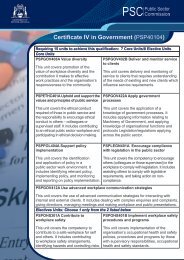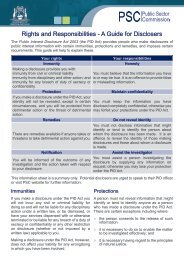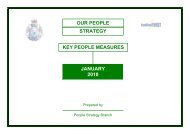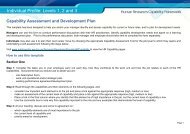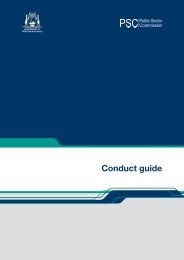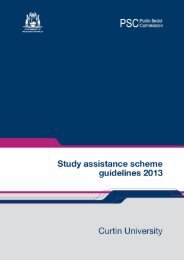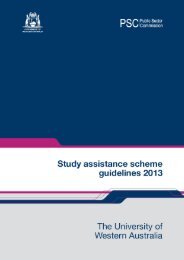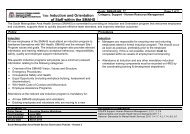Archived document - Public Sector Commission - The Western ...
Archived document - Public Sector Commission - The Western ...
Archived document - Public Sector Commission - The Western ...
You also want an ePaper? Increase the reach of your titles
YUMPU automatically turns print PDFs into web optimized ePapers that Google loves.
Phase Four – Transformation<br />
This phase is characterised by a seamless interface and integrated<br />
service delivery model in which the relationship between citizens,<br />
government and business has been transformed. Multiple channels of<br />
service delivery are a given, and new means of service delivery are<br />
being continuously explored. <strong>The</strong> mechanisms of e-government are<br />
taken for granted as part of everyday life and e-government as a<br />
concept effectively ‘disappears’ to become simply ‘government’.<br />
Citizens and business have an implicit trust and confidence in their<br />
engagement with government, and the concept of ‘government as a<br />
servant of the public’ is truly realised as personalised, pro-active<br />
service delivery mechanisms abound.<br />
<strong>The</strong> distinctions between agencies at all three levels of government<br />
(local, state, federal) are notional as collaborative service delivery is<br />
not only the norm, but a means of achieving and delivering previously<br />
unconceived levels of service. Government services are fundamentally<br />
personalised, independent of channel of delivery or service provider<br />
and frequently transparent.<br />
Government itself is highly accountable, and the mechanisms for<br />
soliciting feedback from citizens have been replaced by mechanisms<br />
that afford citizens a highly participative role in decision-making,<br />
direction and policy.<br />
This Strategy provides the framework by which the public sector may<br />
be able to move towards a transformed government that meets the<br />
needs and expectations of the citizens of <strong>Western</strong> Australia.<br />
Technology alone will not achieve this goal. It will require a long-term<br />
commitment to a program of continuous improvement that critically<br />
challenges longstanding, but outmoded, operational and cultural norms.<br />
‘e-Government enables the dual goals of efficiency and<br />
democracy to be met more cheaply and easily than previously<br />
envisaged but the new technologies go much further than<br />
this. <strong>The</strong>y are starting to redefine the landscape of<br />
government by changing the relationships (power and<br />
responsibility) between players – between service providers<br />
and industry, between the public and private sectors and<br />
between government and citizen – by forging new<br />
organisational and economic structures, by introducing new<br />
processes at work and in the community and above all by<br />
opening new opportunities as well as posing new challenges,<br />
not least the threat of new digital divides.’<br />
Organisation for Economic Co-operation and Development, (2003),<br />
<strong>The</strong> e-Government Imperative, www.oecd.org<br />
15




